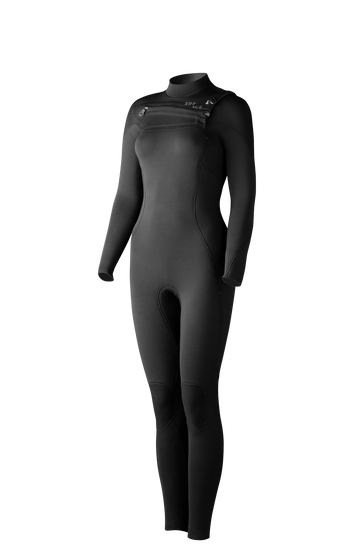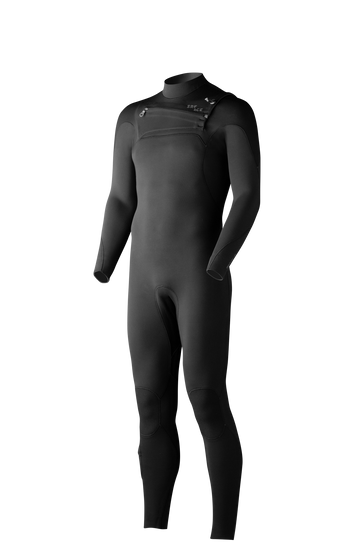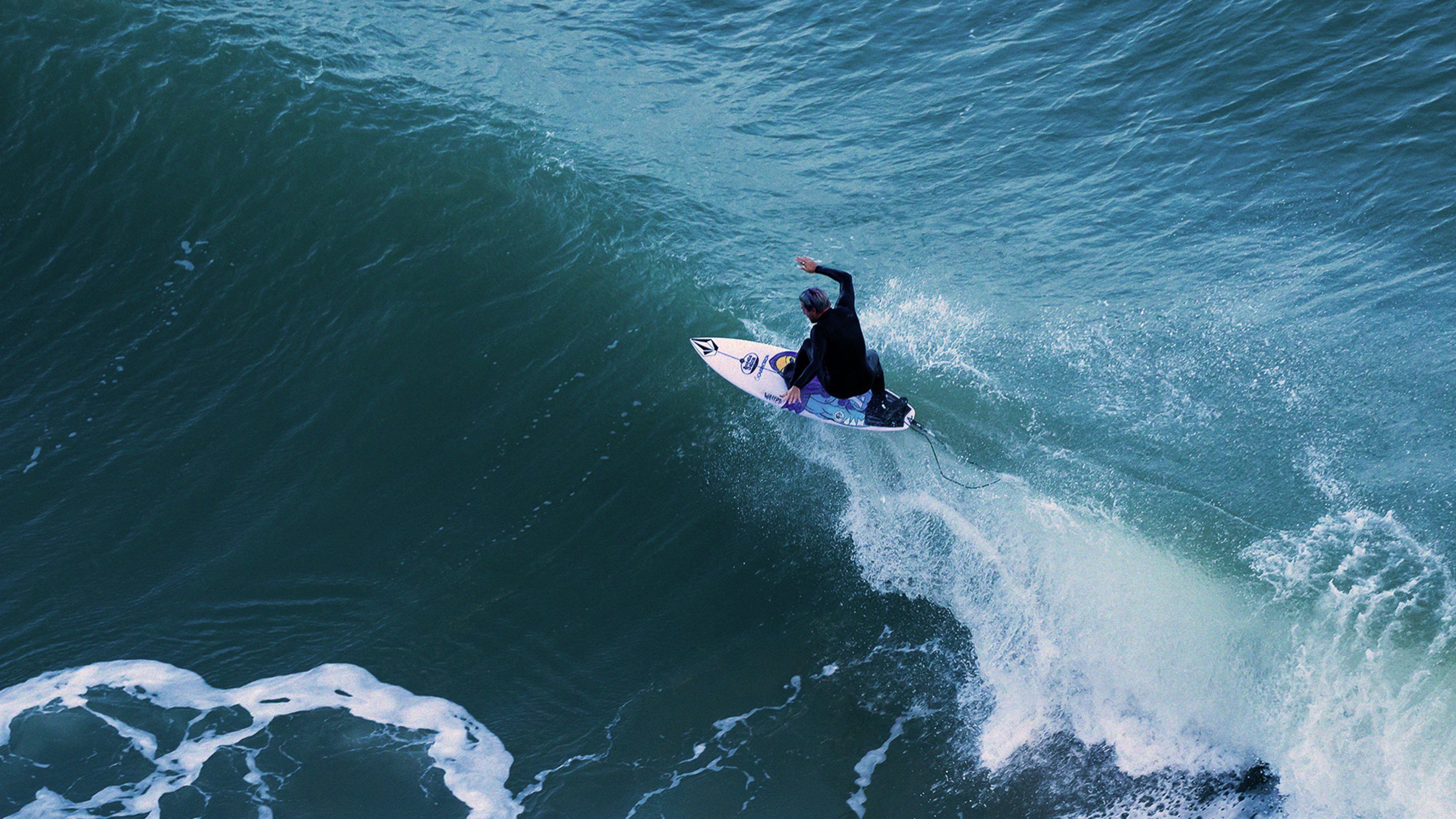
WHY USE WINTER WETSUITS?
When the temperature drops in autumn, warm winter wetsuits become vital. Surfers have been on a quest for decades to find a way to surf longer without getting cold. It all really took off in the early ’50s with the development of the first neoprene surfing wetsuits in California. Without protection, you physically can’t stay in cold water for long before hyperthermia sets in, with life-threatening consequences. Therefore a good winter wetsuit is a must-have for every surfer. Surfing in the middle of winter has become normal, and taking a winter break has become a thing of the past. A winter wetsuit, or steamer, refers to a full wetsuit with waterproof seams. Winter wetsuit neoprene thicknesses range between 4, 5, 6 and sometimes even 7mm. Make sure to choose the most flexible wetsuit with the best seam construction for your budget. This way you’ll remain mobile and stay comfortable.
 WINTER WETSUIT NEOPRENE THICKNESS
WINTER WETSUIT NEOPRENE THICKNESS
The choice of your wetsuit’s neoprene thickness is an important decision based on the water temperatures you are planning to surf in. This is mostly defined by your location and time of the year.
4/3 MM WETSUIT: WATER TEMPERATURES AROUND 12~15°C
Let’s start with the most used wetsuit thickness in the European Atlantic ocean and the North Sea waters. A 4/3 mm wetsuit thickness is ideal for most surfers in western Europe that want to surf from spring all the way to the beginning of winter. A 4/3 mm is most often classified as an all-season wetsuit rather than a full winter wetsuit, but for southern Europe, this is the perfect wetsuit to wear all winter. So location and water temperatures play a big role in defining the perfect winter wetsuit for you. On a 4/3 mm, also called a 4.3 or 4 mm, the 4mm panels are located in the body and upper legs panels. The 3mm panels are located in the arms and lower legs where they allow for more flexibility. A 4/3 wetsuit usually doesn’t have a built-in hood, but some brands do sell a hooded 4/3 mm.
5/4 MM WETSUIT: WATER TEMPERATURES AROUND 8~10°C
The most common thickness for a winter wetsuit is 5/4 mm, also called a 5.4 or 5 mm. It is slightly warmer than a 5/3 mm due to the extra millimetre thickness in the arms. The main body panels and upper legs are 5mm in thickness, while the arms, shoulders and back of the lower legs are made with 4mm panels. A 5/4 mm wetsuit can be made with panels ranging between 5 and 4 mm. However, the panel thickness is not always specified in the thickness description. So it could be that your side panels are 4.5mm for example. The collar panel is usually thinner than 3mm and isn’t usually specified in a product description.
Choose your wetsuit
5/4 MM HOODED WETSUIT: WATER TEMPERATURES AROUND 4~10°C
A 5/4 mm hooded wetsuit is the ideal mid-winter wetsuit for most people in Europe. They are very warm because they insulate the head properly too. If you combine this wetsuit with some neoprene winter booties and neoprene gloves, you can surf all winter without a problem. A 5/4 hooded usually has the same construction as a normal 5/4, with the addition of an attached hood. In spring, when your hooded wetsuit becomes too warm, you can consider wearing a normal 5/4 mm without hood, or switch directly to a spring/autumn wetsuit such as a 4/3 mm.
6/4 MM AND THICKER WETSUIT: WATER TEMPERATURES BELOW 8°C
When water gets below 8 degrees, a built-in hood is advisable. Wearing a 5/4 mm without a hood is still an option, but you will find that you will get cold quickly when duck diving. Ice cream headaches are not fun. For the real die-hards that surf subzero conditions in northern Europe or conquer winters in Scotland and Ireland, a 6/5 mm or even 7 mm wetsuit isn’t a bad idea. But these wetsuits are becoming harder to come by as thermal insulation properties of 5/4 wetsuits are improving. We’ve tested our 5/4 hooded wetsuits in freezing conditions and we’re proud to say: They did the job.

FIXED HOOD OR SEPARATE HOOD?
You lose a lot of heat through your head, especially in sub-zero temperatures. Therefore, keeping your head warm is an effective way to maintain body heat and prevent hyperthermia. Wearing a neoprene hood is the best way to stay warm longer. There are wetsuits available with a built-in hood, or you can buy a separate hood to wear with any wetsuit. However, a wetsuit with built-in hood seals off much better, so it’s usually worth spending the extra money on them. A 5/4 mm wetsuit with a built-in hood is the best option for most surfers in western Europe. You can consider a 6 mm or thicker hooded wetsuit in the middle of winter in northern European countries like Norway or Denmark. Hooded wetsuits also do a great job in preventing surfers ear. A hood blocks wind hitting your ears, which can cause surfers ear even in warmer weather.
Featured wetsuits
WINTER WETSUIT SEAM CONSTRUCTIONS
The right seam construction is important in a warm wetsuit. There are a few different seam constructions for winter wetsuits. Choose a high-end seam construction for a longer lifespan of your wetsuit. At all costs, avoid flatlock seams in any winter wetsuit, as they are not waterproof and will make you get cold quickly.

GBS / GLUED AND BLIND STITCHED
Glued and blind stitched wetsuit seams are the most common, but not the most high-end seam construction used in winter wetsuits. Glued and blind stitched seams prevent water from entering your wetsuit. The GBS process creates a strong and waterproof glued and stitched seam. We recommend buying a winter wetsuit with sealed seams for extra insulation and durability.

LIQUID SEALED SEAMS
A high-quality way of finishing a traditional GBS seam is adding a liquid neoprene seal on top of the stitching. Winter wetsuits benefit the most from liquid sealed seams. The liquid seal reinforces the seam and over time, it prevents pinholes to form in areas where multiple wetsuit panels come together. It’s a more durable construction and lasts longer than normal GBS seams. The technical name for this seam construction is S-seal.
POWERSEAMS
Powerseams are a narrower version of a liquid neoprene seam without blind stitching on the outside. Usually, powerseams have blind stitching on the inside of the wetsuit or are completely stitchless. Powerseams come in a variety of colours. Due to the thin seal without the reinforcement of blindstitching, powerseams are less durable than wider S-seal liquid sealed seams.

TAPED INSIDE SEAMS
The strongest reinforced high-end wetsuit seam construction includes neoprene tape applied on the seam’s inside. Neoprene tape, also called neotape, can be applied to the inside of both GBS or liquid seam-sealed seams. Neotape inside seams make the seam even more waterproof by forming an extra layer of protection against water leaks. It also protects against seam irritation to the skin. You can glue on neotape by hand, or apply it with a heat welding machine. Hand-glued tape can leave traces of glue next to the tape, which can cause irritation to the skin. Machine welded tape, also called neotape 2.0, eliminates the glue residue and forms a nice and flat inside seam.

DOUBLE LINED OR SINGLE LINED WETSUIT?
Should you buy a single lined or double lined neoprene winter wetsuit? Firstly, single lined neoprene also referred to as mesh, glideskin or smoothskin can be used as an outside finish of a wetsuit panel. The outside surface looks more like smooth rubber, while double lined neoprene has a woven textile coating. Single lined neoprene has a heat-sealed outside skin surface which seals the raw sliced neoprene foam to make it durable and water repellant. You’ll find single lined neoprene on chest and back panels of a wetsuit to keep you warmer in windy and cold conditions. The water-repellent surface makes the water droplets run down faster. This protects you against windchill and makes it warmer than double lined neoprene. Single lined neoprene doesn’t have a protective lining, so be aware when taking off your wetsuit, to not damage single lined neoprene with your fingernails.

DOUBLE LINED NEOPRENE
Double lined neoprene is a stronger but colder type of neoprene. To create double lined, or double nylon neoprene, we laminate knitted jersey to broth the inside and outside of the neoprene. Double lined neoprene doesn’t let water completely through. However, it is not water repellant like single lined neoprene either. Water droplets on the outside lining will cool you down because of windchill, even with a slight breeze. The lining will however make wetsuits more durable and protects the neoprene foam against outside influences like UV and ozone. Most wetsuits are lined on the inside with a flexible and soft jersey that is comfortable to wear on the skin. Single lined neoprene is usually black, in contrast, double lined neoprene comes in a range of different colours.

SINGLE AND DOUBLE LINED NEOPRENE COMBINED
Modern high-end winter wetsuits usually come in a combination of single and double lined panels, strategically placed to ensure ultimate performance and warmth. SRFACE uses water repellant, extra thick and warm panels on the chest and back to keep you warm, while we use thinner more flexible double lined panels on the arms and legs to enhance flexibility and unrestricted movement. For areas where you need extra warmth, we use push quick-dry inside lining. This plush lining even makes it possible to make fully double lined wetsuits. However, for a warm winter wetsuit, single lined chest and back panels are still essential to retain body heat.
 PLUSH INSIDE LINING
PLUSH INSIDE LINING
Plush insulation or quick-dry inside lining has gained popularity in high-end cold water wetsuits over the past years. It’s the fleece type inside lining that helps retain body heat. It insulates the wetsuit by trapping air bubbles between the hollow nylon fibre lining and your body. Plush usually has a quick-drying function, which allows a wetsuit to feel dry to the skin. Water is channelled to the back of the lining, where it runs down the wetsuit. This also allows the wetsuit to dry quickly between sessions. Plush lining is mainly used on body panels where extra warmth is needed and flexibility is less important. Plush lining can take away some of the stretch of the neoprene. The arms, shoulders and lower legs of a wetsuit are usually made with the most flexible stretch lining without adding quick-dry lining.

Ready to surf?
Shop from €159











